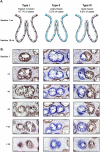Crypt fusion as a homeostatic mechanism in the human colon
- PMID: 30872394
- PMCID: PMC6839731
- DOI: 10.1136/gutjnl-2018-317540
Crypt fusion as a homeostatic mechanism in the human colon
Abstract
Objective: The crypt population in the human intestine is dynamic: crypts can divide to produce two new daughter crypts through a process termed crypt fission, but whether this is balanced by a second process to remove crypts, as recently shown in mouse models, is uncertain. We examined whether crypt fusion (the process of two neighbouring crypts fusing into a single daughter crypt) occurs in the human colon.
Design: We used somatic alterations in the gene cytochrome c oxidase (CCO) as lineage tracing markers to assess the clonality of bifurcating colon crypts (n=309 bifurcating crypts from 13 patients). Mathematical modelling was used to determine whether the existence of crypt fusion can explain the experimental data, and how the process of fusion influences the rate of crypt fission.
Results: In 55% (21/38) of bifurcating crypts in which clonality could be assessed, we observed perfect segregation of clonal lineages to the respective crypt arms. Mathematical modelling showed that this frequency of perfect segregation could not be explained by fission alone (p<10-20). With the rates of fission and fusion taken to be approximately equal, we then used the distribution of CCO-deficient patch size to estimate the rate of crypt fission, finding a value of around 0.011 divisions/crypt/year.
Conclusions: We have provided the evidence that human colonic crypts undergo fusion, a potential homeostatic process to regulate total crypt number. The existence of crypt fusion in the human colon adds a new facet to our understanding of the highly dynamic and plastic phenotype of the colonic epithelium.
Keywords: colon crypt; crypt fission; crypt fusion; evolutionary dynamics; lineage tracing; mathematical modelling.
© Author(s) (or their employer(s)) 2019. Re-use permitted under CC BY. Published by BMJ.
Conflict of interest statement
Competing interests: None declared.
Figures



References
Publication types
MeSH terms
Substances
Grants and funding
- 27145/CRUK_/Cancer Research UK/United Kingdom
- G0901178/MRC_/Medical Research Council/United Kingdom
- A19771/CRUK_/Cancer Research UK/United Kingdom
- BB_/Biotechnology and Biological Sciences Research Council/United Kingdom
- 14895/CRUK_/Cancer Research UK/United Kingdom
- 19771/CRUK_/Cancer Research UK/United Kingdom
- MC_PC_12009/MRC_/Medical Research Council/United Kingdom
- A14895/CRUK_/Cancer Research UK/United Kingdom
- 209409/Z/17/Z/WT_/Wellcome Trust/United Kingdom
- U54 CA217376/CA/NCI NIH HHS/United States
- 202778/Z/16/Z/WT_/Wellcome Trust/United Kingdom
- 098357/WT_/Wellcome Trust/United Kingdom
LinkOut - more resources
Full Text Sources
